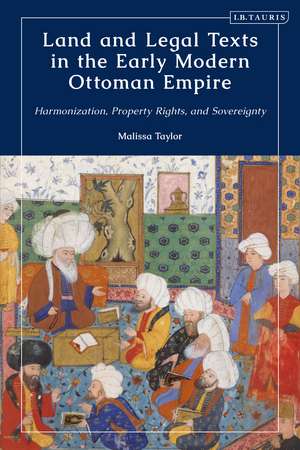Land and Legal Texts in the Early Modern Ottoman Empire: Harmonization, Property Rights and Sovereignty: The Ottoman Empire and the World
Autor Malissa Tayloren Limba Engleză Hardback – 18 oct 2023
Preț: 509.93 lei
Preț vechi: 730.93 lei
-30% Nou
Puncte Express: 765
Preț estimativ în valută:
97.59€ • 105.96$ • 81.97£
97.59€ • 105.96$ • 81.97£
Carte tipărită la comandă
Livrare economică 22 aprilie-06 mai
Preluare comenzi: 021 569.72.76
Specificații
ISBN-13: 9780755647682
ISBN-10: 0755647688
Pagini: 216
Dimensiuni: 156 x 234 mm
Greutate: 0.48 kg
Editura: Bloomsbury Publishing
Colecția I.B.Tauris
Seria The Ottoman Empire and the World
Locul publicării:London, United Kingdom
ISBN-10: 0755647688
Pagini: 216
Dimensiuni: 156 x 234 mm
Greutate: 0.48 kg
Editura: Bloomsbury Publishing
Colecția I.B.Tauris
Seria The Ottoman Empire and the World
Locul publicării:London, United Kingdom
Caracteristici
Demonstrates that legal limits on the dynasty's power to dispossess peasant cultivators was a fundamental part of the empire's tradition of land law since the 16th century
Notă biografică
Malissa Taylor is Assistant Professor of Middle Eastern Studies at University of Massachusetts Amherst, USA. Her published articles have appeared in Journal of the Economic and Social History of the Orient and The Journal of Ottoman Studies.
Cuprins
IntroductionSourcesHarmonization and SovereigntyProperty: Bundles and Layers1. Lifelong tasarruf, Land Tenure Practices, and Law over the longue durée Ottoman territories and varieties of tenure for the military class Cultivator Tenure and its legal Systemization Military fiscal change and land tenure Land tenure rights trickle up The Old and the New2. Conquering a New Terrain: Establishing the Sultan's Legislative AuthorityTexts and Contexts "Preserved in the Bayt al-Mal": Acquiring Land for the Treasury "Neither Tithe nor Kharaji": The Status of the Land for Transaction and TaxBuilding a coherent lawConclusion3. Canonical Voices: Discretion and analogy in the formation of the harmony tradition of land tenureContexts of the TextPir Mehmed and Sultanic LatitudeThe Formation of a Tradition: Deferential and not so Deferential InterpretationConclusion4. "The Books of Fiqh": The Kanunname of Candia and the Consolidation of a New Doctrine in Hanafi Academic TextsHarmony at a crossroadsThe Kanunname of Candia as critique: Reinstituting the Hanafism of the "books"The Sultan as Legislator: texts, commentaries and fatwasThe Change in Doctrine: the sultan has a choiceConclusion5. The Age of the Mutasarrifs: Diffusion, Rights, and Discretion in the Eighteenth CenturyBackgroundConvergenceExpansive Transactions: Permission and AnalogismConclusion6. From Harmony to Uniformity: Defensive Sovereignty and the Ottoman Nineteenth-Century ReformsMiri Tasarruf: Stability in a sea of changeCreating a Normal SubjectCodifying Islamic LawDefending Islam: From "built on the kanun" to "built on the fiqh"ConclusionConclusionBibliography
Recenzii
A mind-blowing and innovative study of the supposedly dry subject of Ottoman land law, gracefully written and designed to overturn all your stereotypes of Islamic law, sultanic power, and Ottoman decline. Taylor is to be congratulated on her deeply original take on obscure but vitally important aspects of imperial legal modernization.
This book shows how three centuries of legislation and legal interpretation, instead of a European model, underlay the Ottoman land code of 1858. Deeply researched and cogently argued, it upends much that we thought we knew about Ottoman history from the age of Süleyman to the Tanzimat era.
Taylor boldly reinterprets the foundational relationship among land/property rights, law/legal authorities and sovereignty in the Ottoman Empire. This ambitious, lucid and compact study recasts peasant cultivators as holding a "bundle of property rights" that slowly "trickled up" to model property rights among the highest-ranking property holders in the empire by the eighteenth century, enduring through land law reforms in the nineteenth. Whether accepted or challenged, Taylor's reconceptualization of the Ottoman agrarian state and society offers a fulcrum for rethinking the entire history of the empire._____________________________
This book shows how three centuries of legislation and legal interpretation, instead of a European model, underlay the Ottoman land code of 1858. Deeply researched and cogently argued, it upends much that we thought we knew about Ottoman history from the age of Süleyman to the Tanzimat era.
Taylor boldly reinterprets the foundational relationship among land/property rights, law/legal authorities and sovereignty in the Ottoman Empire. This ambitious, lucid and compact study recasts peasant cultivators as holding a "bundle of property rights" that slowly "trickled up" to model property rights among the highest-ranking property holders in the empire by the eighteenth century, enduring through land law reforms in the nineteenth. Whether accepted or challenged, Taylor's reconceptualization of the Ottoman agrarian state and society offers a fulcrum for rethinking the entire history of the empire._____________________________




